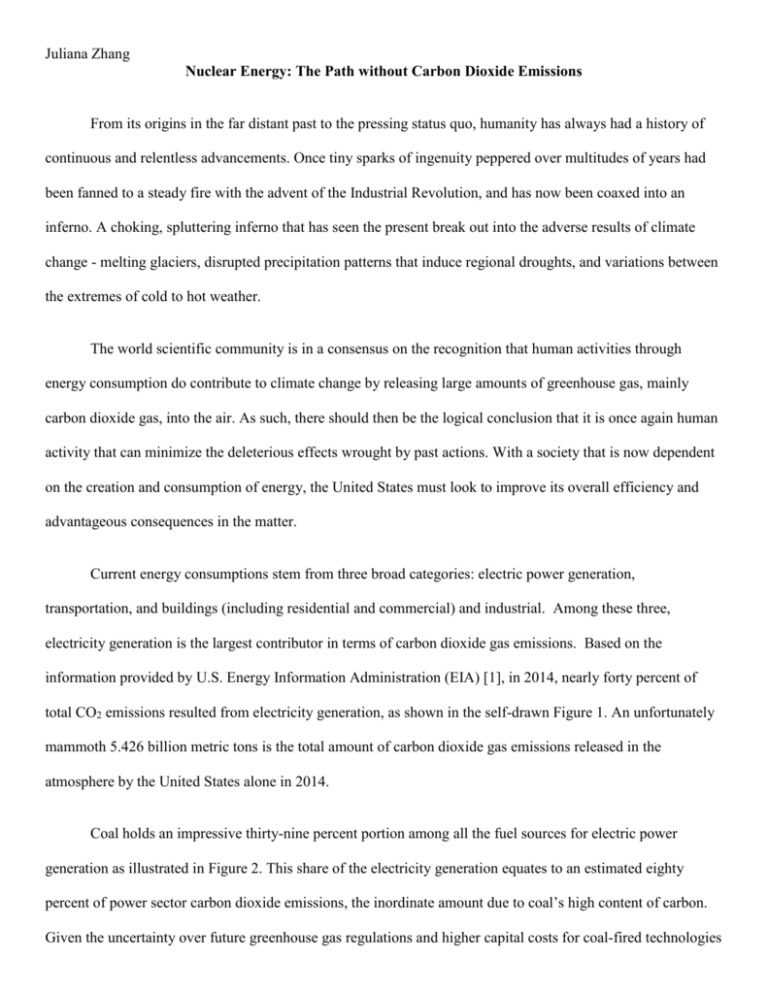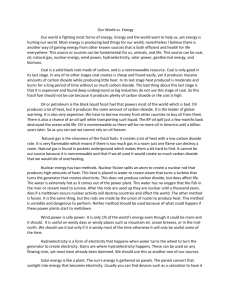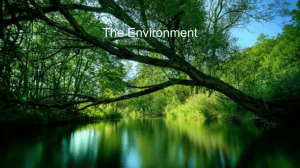Juliana_Zhang_essay
advertisement

Juliana Zhang Nuclear Energy: The Path without Carbon Dioxide Emissions From its origins in the far distant past to the pressing status quo, humanity has always had a history of continuous and relentless advancements. Once tiny sparks of ingenuity peppered over multitudes of years had been fanned to a steady fire with the advent of the Industrial Revolution, and has now been coaxed into an inferno. A choking, spluttering inferno that has seen the present break out into the adverse results of climate change - melting glaciers, disrupted precipitation patterns that induce regional droughts, and variations between the extremes of cold to hot weather. The world scientific community is in a consensus on the recognition that human activities through energy consumption do contribute to climate change by releasing large amounts of greenhouse gas, mainly carbon dioxide gas, into the air. As such, there should then be the logical conclusion that it is once again human activity that can minimize the deleterious effects wrought by past actions. With a society that is now dependent on the creation and consumption of energy, the United States must look to improve its overall efficiency and advantageous consequences in the matter. Current energy consumptions stem from three broad categories: electric power generation, transportation, and buildings (including residential and commercial) and industrial. Among these three, electricity generation is the largest contributor in terms of carbon dioxide gas emissions. Based on the information provided by U.S. Energy Information Administration (EIA) [1], in 2014, nearly forty percent of total CO2 emissions resulted from electricity generation, as shown in the self-drawn Figure 1. An unfortunately mammoth 5.426 billion metric tons is the total amount of carbon dioxide gas emissions released in the atmosphere by the United States alone in 2014. Coal holds an impressive thirty-nine percent portion among all the fuel sources for electric power generation as illustrated in Figure 2. This share of the electricity generation equates to an estimated eighty percent of power sector carbon dioxide emissions, the inordinate amount due to coal’s high content of carbon. Given the uncertainty over future greenhouse gas regulations and higher capital costs for coal-fired technologies Juliana Zhang to sequester carbon dioxide emissions, the sector of coal generation is expected to fall to thirty-two percent in 2040. However, coal-fueled electric power generation will continue to be the main source of carbon dioxide gas emission for the electric power generation sections. To properly control and alleviate greenhouse gas emission, the coal-fired plants need to be replaced with no-emitting or low emitting electric energy generation technologies. This is a gap with the potential to be filled tremendously by renewable energy, and even more so, nuclear energy. Figure 1. Illustration of CO2 gas emissions in the U.S. in 2014 (data taken from reference 1) Juliana Zhang Other Renewables 6% Hydropower7 % Petroleum 1% Other 1% Coal Natural Gas Coal 39% Nuclear 19% Nuclear Hydropower Other Renewables Natural Gas 27% Petroleum Other Figure 2. Illustration of electricity power generation from various sources (data taken from reference 1) Renewable energy sources such as hydroelectric power, wind power, solar energy, geothermal power, and biomass energies are possible alternatives to the heavily used modern energy generation sources. Each, regardless of their defining characteristics, are not without their distinct advantages and disadvantages. The hydroelectric power resources currently account for about seven percent of electric power generation. However, the future of hydropower can only see limited growth as the hydropower resources have been tapped out. Geothermal and biomass energy sources are available in multiple regions, but are subject to the dangers of their geological locations while working on already limited scales. Even wind and solar power, with their most substantial potential to grow, are not true panaceas to the energy issues confronting the world. The hundreds of windmills, still being continuously built and added to, dot the Idaho Falls skyline in impressive stature. The casual glance up toward the hills gives undeniably concrete evidence that this city has abundant wind power from the rotating and producing power windmills. The sun can bring not only warm weather, but the solar power that also has great growth potential. However, wind power and solar power availability are subject to the merciless whims of Mother Nature. When the wind ceases to blow and the sun sets to let evening bloom, there will be no power. As intermittent energy sources that are entirely too unreliable for a society that needs power at all times, wind and solar power can only be used as energy supplements at most. Though great augmenting agents to other more stable electricity sources like coal, natural gas, or nuclear, both Juliana Zhang wind and solar power require significant amounts of land. The required land size is hundreds of times the land needed for the equivalent electricity production from nuclear energy. A drive from Lincoln Road to the Blacktail park of Ririe Reservoir is all that is needed to see that in reality, the seemingly white spots on the skyline inhabit what is a vast amount of land. The acreage dedicated for wind farms pits energy generation in direct competition with the land use from other sectors such as housing and agriculture. Competition with other fields with also pressing responsibilities would limit wind power’s potential for growth. Wind power is also disadvantaged in that wind power rich regions are often far from major population centers, which would add costs for power delivery and make the fuel source less attractive for investors to invest into with technology. Nuclear energy, as a near emissions-free electric energy source, offers a pragmatic solution to curb the carbon dioxide gas emissions while providing stable electricity production. With several decades of operating experience, the nuclear energy industry has proven itself reliable and safe. To understand the impacts of greenhouse gas emission, one must understand that “life-cycle” emissions is the amount of greenhouse gas emissions in the life cycle of a power producing facility from construction to operation. Regarding carbon dioxide gas emission, studies have shown that nuclear energy’s “life-cycle” emissions of carbon dioxide are comparably similar to renewable energy sources such as solar, wind and hydro power, as illustrated in Figure 3 [2]. The data shown in Figure 3 coincides with the analysis done by Benjamin K. Sovacool [3]. Juliana Zhang Figure 3. Illustration of lifecycle CO2 emissions from various sources (figure copied from reference 3). Figure 4. Illustration of CO2 gas emissions by fuel types Total carbon dioxide gas emissions from electricity power generation is at 2.098 billion metric tons (Figure 1) and coal’s contributions are at roughly an immense eighty percent, or 1.678 billion metric tons. If we were to expand nuclear energy’s share in power generation from the roughly twenty percent to forty percent in the future, power generation dependent upon coal-fired plants would be effectively halved from the current forty percent to twenty percent. The result would be 839 million metric tons fewer in carbon dioxide gas emissions. This action alone would account for about a fifteen percent (839 million metric ton divided by 5426 million metric ton which is the total carbon dioxide gas emission in 2014) reduction of carbon dioxide gas emissions. As shown in Figure 1, other carbon dioxide emitters include the transportation sector and the buildings and industrial sector. Examining the carbon dioxide gas emissions by fuel type, as shown in Figure 4, will allow us to see that petroleum is the largest contributor to carbon dioxide gas emissions. Petroleum, used mainly in the transportation sector, accounts for about forty-two percent of the total carbon dioxide gas emissions – this number is expected to remain the same in the near future and long term. A plentiful and inexpensive electricity supply from nuclear energy would allow for more electric cars, such as those designed by Tesla that can then be sold to gradually replace the current fleet of cars powered by petroleum. Inexpensive electricity can also be Juliana Zhang utilized to replace natural gas in heating buildings, thus further reducing carbon dioxide gas emissions. Even though construction of nuclear power plants costs several billions of dollars and spans many years, to allow the potential benefits of nuclear energy to slip by would be a serious transgression in practicality for today’s society. The projections for nuclear energy outlined thus far, do not even take into account the full effectiveness that nuclear energy would reach if research is conducted into closing the fuel cycle. New ideas and developments are necessary to allow power generation companies to undertake the creation of nuclear power plants that are less capital intensive to build, and provide net benefits of unparalleled heights. Idaho National Laboratory has a broad portfolio in nuclear energy research, ranging from next generation of nuclear reactors and advanced fuel and fuel cycle studies to extending the lifetime of current nuclear power plants. Advanced reactor designs utilize passive safety by taking advantage of the law of physics. Small modular reactors are one of the reactor types that offer the potential to reduce construction costs and shorten construction time. Another type of advanced reactor being studied is the next generation nuclear power plant (NGNP) which is a high temperature reactor design that is capable of producing both hydrogen and electricity. The hydrogen produced can power fuel cell vehicles which can replace gasoline powered vehicles. These designs are much more simplified than the current generation of reactors in operation and will be more cost-cutting to build. They would also avoid Fukushima type of disasters from happening and assuage any of the public’s fear about nuclear energy. The research conducted and any products that come to fruition will all help the nation to develop the technologies readily available for advanced nuclear power plants to be built while maintaining the current fleet of nuclear power plants viability by prolonging their lifetime. I myself am planning on pursuing studies in college that will allow me to cross cut different engineering disciplines to solve real life problems – especially in helping society advance to energy security and greenhouse gas free energy source via promoting nuclear energy. However, the future for nuclear energy despite the great benefits and promise that it brings is not as assured as one would think. Based on EIA’s projection, the power generation share from nuclear energy will become reduced to sixteen percent from the current level of twenty percent because more nuclear power plants will be retired while fewer new nuclear power plants would come on-line. To reverse such trend, a concerted effort will be needed to increase public support about nuclear Juliana Zhang energy. It would be favorable to also influence Congress on energy policy to provide more support to nuclear energy such as allotting more research funding to the national laboratories and universities to make nuclear reactors less expensive to build and even safer to operate. The government should also be motivated to provide financial incentives for the construction of new nuclear power plants as such incentives can assure cost recovery to the investors in these investments. As the energy source with the most long-term benefits and a pragmatic outlook, nuclear power will simultaneously reduce greenhouse gas emissions while producing much needed energy. Juliana Zhang References: 1. Energy Information Administration, http:://www.eia.doe.gov. 2. Nuclear Energy Institute, http:://www.nei.org. 3. Benjamin K. Sovacool, “Valuing the greenhouse gas emissions from nuclear power: A critical survey”, Energy Policy 36 (2008) 2940– 2953.







